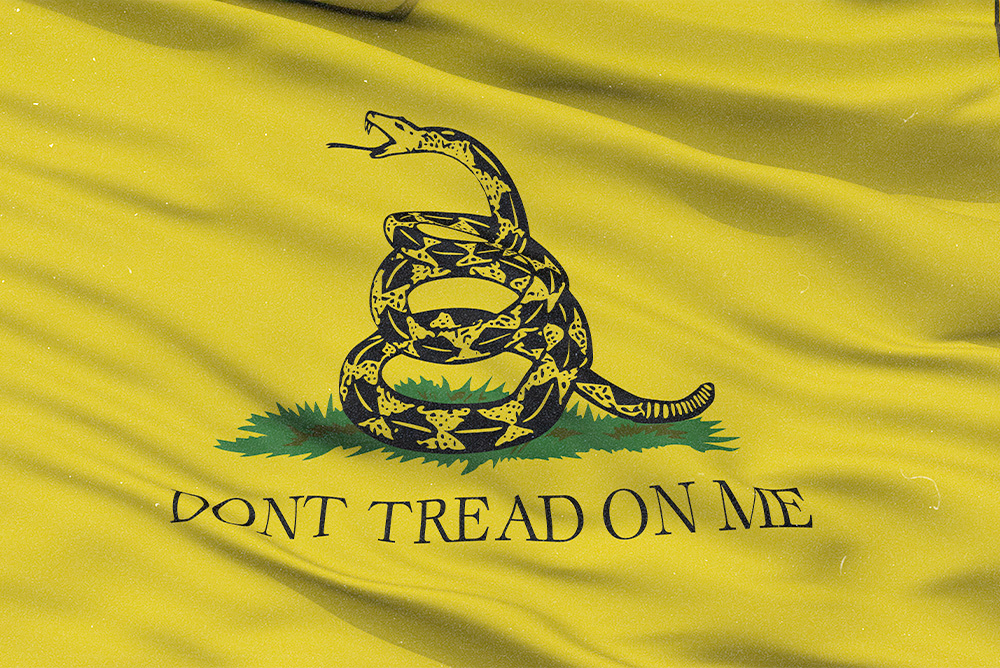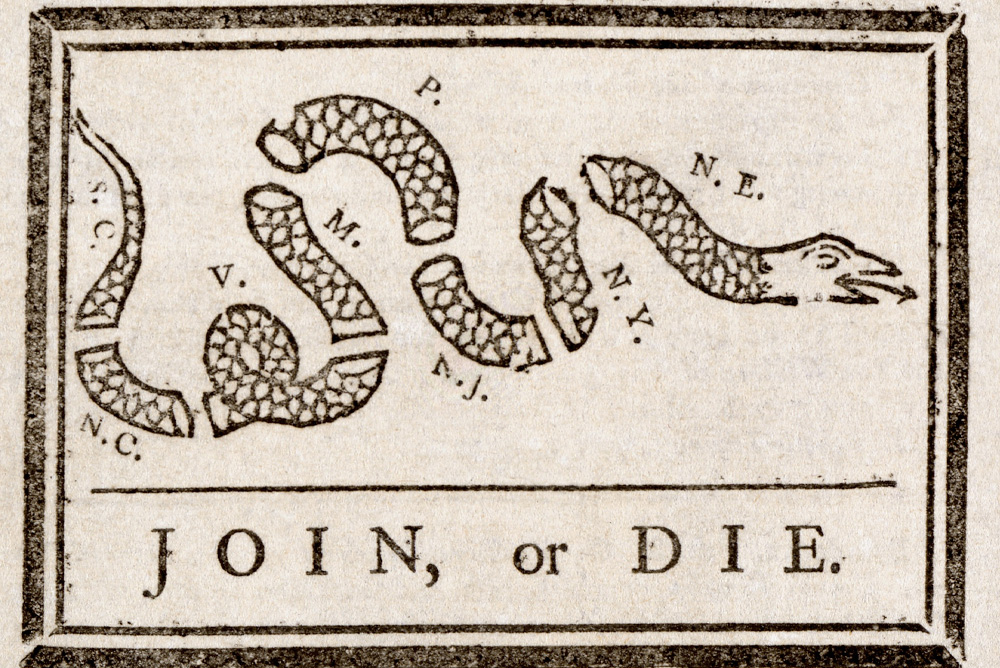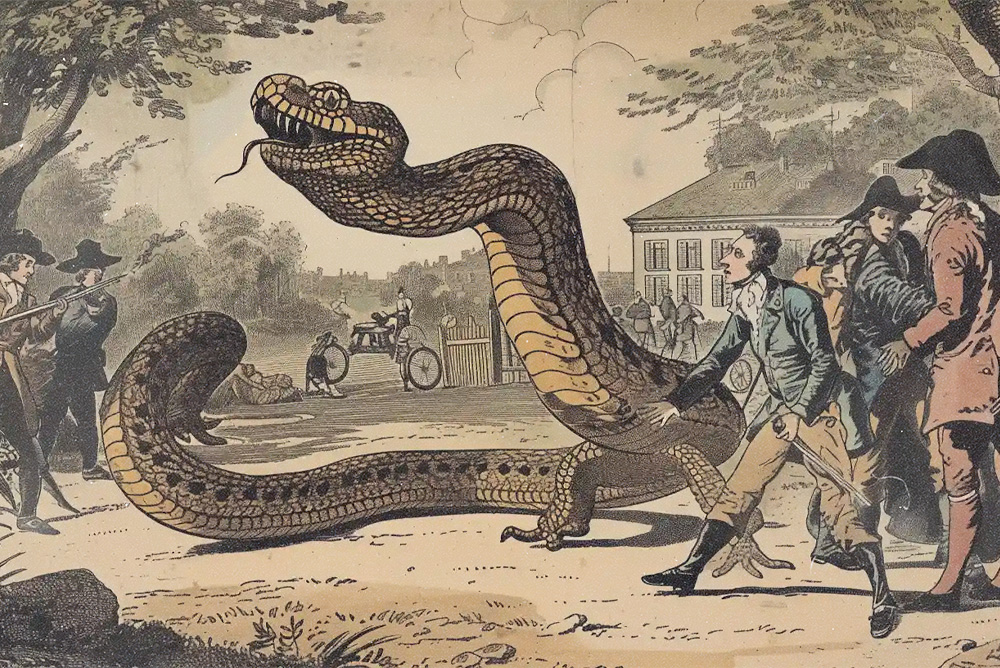‘Don't Tread on Me’: The Origin of the Gadsden Flag

Most Americans are familiar with the Gadsden flag, whether they know it by name or not. The iconic emblem is easily recognizable, featuring a bright yellow background, a coiled rattlesnake, and the famous rally cry “Don’t Tread on Me.”
But, what exactly is the story behind this famous flag, and is its message still relevant today?
The Gadsden flag is a symbol that dates back to the American Revolution. Its statement, “Don’t Tread on Me,” is one that, despite some controversy over the years, has long stood for freedom, independence, and a willingness to fight for liberty.
In this article, we’ll go in-depth about the origin and meaning behind Don’t Tread on Me, what it stands for today, and how you can support the movement. Let’s get started.
What is the Gadsden Flag? Elements and Symbolism
The “Don’t Tread” flag is one that most people recognize – after all, it’s pretty hard to miss! Traditionally made with a bright yellow background, the flag has several unmistakable features, each with its own meaning.

Timber Rattlesnake
The first and most prominent symbol of the Gadsden flag is the coiled timber rattlesnake, its mouth open and ready to strike. The rattlesnake had already become a well-known political symbol in America at the time thanks to the influence of Benjamin Franklin. During the French and Indian War in 1754, Franklin drew and published a political cartoon featuring a rattlesnake cut into eight pieces, representing eight colonies or regions, with the words “Join, or Die,” according to AmericanFlags.com.
Franklin used a rattlesnake to make a statement several times throughout history, as he felt it was a fitting representation of the United States. He outlined this symbolism in a letter published in the Pennsylvania Journal under the pseudonym “An American Guesser” in 1775, where he compared the 13 rattles in its tail (representing the 13 colonies) and the vigilance of the rattlesnake to America.

“She never begins an attack, nor, when once engaged, ever surrenders: She is therefore an emblem of magnanimity and true courage. As if anxious to prevent all pretensions of quarreling with her, the weapons with which nature has furnished her, she conceals in the roof of her mouth, so that, to those who are unacquainted with her, she appears to be a most defenseless animal; and even when those weapons are shown and extended for her defense, they appear weak and contemptible; but their wounds however small, are decisive and fatal. Conscious of this, she never wounds 'till she has generously given notice, even to her enemy, and cautioned him against the danger of treading on her,” he wrote.
Don't Tread on Me Meaning
The final element of the Gadsden flag is the words written in bold capital letters underneath the snake. The meaning behind “Don't Tread on Me,” originally spelled without an apostrophe (as was customary at the time), is pretty self-explanatory.
In combination with the visual of the rattlesnake, the words sent a warning that anyone who tried to walk on or otherwise mess with the United States would be struck down. Although it may not look too threatening at first glance, treading on a rattlesnake, and metaphorically a young America, would be a big mistake. The motto resonated with patriots at the time, who were fighting for independence from Great Britain, and it still does for many people today.
Gadsden Flag History
The original Gadsden flag was first flown during the American Revolution, sending a clear message to the British that young America meant business. The “Don’t Tread on Me” history is a fascinating one, and it’s important to understand the meaning behind these symbols when we use them today.

Gadsden and Hopkins
Although Benjamin Franklin’s “Join or Die” cartoon inspired the Don’t Tread on Me flag, he is not the one who created it. The flag is known as the Gadsden flag, and sometimes the Hopkins flag, for a reason: the influence of Colonel Christopher Gadsden and Commodore Esek Hopkins.
Gadsden, who was the principal leader of the patriot movement in South Carolina, designed the flag in 1775 using the political symbol of the snake. He gave the flag as a gift to Hopkins, the commander of the new U.S. Navy. Hopkins loved the design so much that he adopted it as his personal banner, flying it for the first time on the USSAlfred on December 20, 1775, in the Chesapeake Bay. He continued flying it from the mainmast every time he was on board the ship, according to the book Christopher Gadsden and the American Revolution. The Continental Marines also took up flying the Gadsden flag during the war. Later, when the “Stars and Stripes” flag was officially named the national flag, the flag took a step back but was still considered a relic and symbol of patriotism until more recent years when it saw a resurgence in popularity.
‘Don’t Tread on Me’ Meaning Today
Although it’s been centuries since the Gadsden flag was first flown, it still holds a great deal of significance and is often seen displayed to this day.
In the 1970s, the Don't Tread on Me flag reentered modern culture with the rise of the American Libertarian movement. Much like it did in the 1770s, it was used to broadly represent independence in the fight for limited government.
In 2009 when the Tea Party movement first began to take root, the Gadsden flag saw yet another resurgence in popular culture, being used to protest issues like taxation and government spending. During this time, the flag became more associated with a particular political stance rather than a simply being a historic emblem, resulting in some controversy over the years.
Today, the flag is displayed by individuals as a symbol of support for national pride, individual rights, and the willingness to defend one's freedom. It has taken on several forms, being made into parodies and artistic variations, and has been used by people from many different backgrounds and ideologies. One thing remains true: the Gadsden flag and the “Don’t Tread” movement still stand for liberty, patriotism, and the fight for freedom.
How Can I Show My Support?
If you’re looking for a way to display your support of the “Don't Tread on Me” movement, there are a few easy ways to do so.
First, you can always fly a Gadsden flag. This classic yellow Don’t Tread on Me flag is made in the USA, and is designed for outdoor use. For a more unique option, check out this grayscale American flag with a yellow Don’t Tread symbol.

A Don’t Tread on Me shirt is one of the best ways to show your support everywhere you go. This Don't Tread on Me T-shirt from Vedder Holsters is not only bursting with patriotism, but it also features a unique graphic design featuring the “join or die” snake symbol.
The “Don’t Tread” symbol has been put on just about everything: from keychains, coffee tumblers, and decorative license plates to decals, hats, and even shooting earmuffs. Pretty much everything you could think of has been made into a “Don’t Tread on Me” statement.
Summary
The Gadsden flag and the message behind Don’t Tread on Me have had major significance in America since the beginning. What started as a cry for freedom and liberty during the American Revolution has stood the test of time and remains a powerful symbol to this day.
To proudly show your support for the Don’t Tread movement, check out the Vedder Nation Don’t Tread T-shirt. If you’re looking for a new IWB, OWB, or pocket carry holster, visit our Holsters by Gun Model page for Kydex holsters that are custom-made for your weapon of choice.
Interested in items beyond holsters? Check out our Resources Page for links to recommended products like lights, lasers, first aid, maintenance, and more, and browse our selection of apparel, and accessories at our website, vedderholsters.com.
To stay up-to-date on all the latest Vedder Holsters content and offerings, check out our blog and follow us on Facebook, Instagram, and Twitter. And be sure to visit our sister company, GeoGrit, for all of your American-made minimalist wallet needs.
*This page contains affiliate links. When you purchase a product included on this list, we receive a commission at no extra cost to you.
